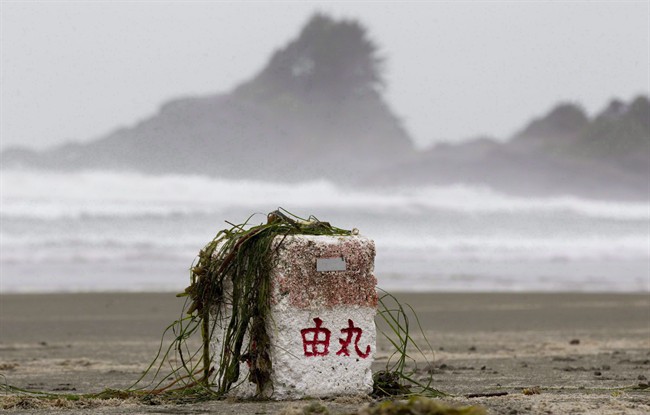VANCOUVER – The manager of a national shoreline cleanup organization says she hopes one legacy of the 2011 Japanese tsunami will be greater awareness of the amount of everyday garbage going into the ocean.

Kate Le Souef of the Vancouver-based Great Canadian Shoreline Cleanup says Japanese detritus swept to sea during the disaster continues to wash ashore along B.C.’s coastline.
“Debris from disasters is not preventable but our everyday garbage is,” Le Souef said in an interview Tuesday.
Wednesday marks the fourth anniversary of the disaster, which saw a magnitude-9.0 earthquake strike off the coast of Japan, sending a series of 10-metre waves racing toward the coastline.
The tsunami killed nearly 19,000 people, injured more than 6,000 and destroyed thousands of coastal buildings.
It also drew about five million tonnes of debris into the Pacific Ocean. An estimated 70 per cent of that material sank while the remaining 1.5 million tonnes were dispersed by ocean currents, including toward North America’s West Coast.
During a recent visit to the Haida Gwaii archipelago off B.C.’s northern coast, Le Souef said she came across many items from Japan, including fishing gear, property markers and wood from destroyed buildings.
“It’s hard to make estimates because lots of the items we find don’t have markings on them,” she said.
But what most struck Le Souef is how much of the debris on B.C.’s beaches consists of household items.
“Tsunami (debris) is just a fraction of what we find on our coastline,” she said.
“The things that are out on the shoreline are from our everyday lives: shampoo bottles, laundry detergent bottles. All the things that we know, that we generate, they’re ending up in the ocean.
Le Souef said anecdotal reports by coastal residents have suggested there’s been an increase in debris washing ashore since the 2011 disaster.
The amount of litter that comes onshore also depends on the weather, she added.
“Go down to the beach after a big storm and you’ll notice a big difference,” said Le Souef.
“There might be suddenly a lot more Styrofoam or a lot more plastic baskets that will have washed in overnight.”
She described the 2013-14 storm season as relatively calm compared with this year.
The shoreline cleanup organization is a collaboration between the Vancouver Aquarium and the World Wildlife Fund. It promotes and oversees cleanup events across Canada.



Comments